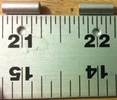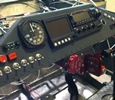


random user submitted photo
Rivet grip ranges.
9 posts
• Page 1 of 1
Rivet grip ranges.
Many of the rivets specified on my Onex plans are connecting thicknesses out of the published grip ranges for the size of rivet. For example on the fuselage sides through the longeron 1/8" plus .035 skin = .160 which is less than .188 specified for a ccp44 rivet. Does anyone know if this is common practice?
Onex 150
- inventor
- Posts: 71
- Joined: Tue Jun 09, 2015 8:35 am
- Location: Oregon
Re: Rivet grip ranges.
I noticed that too. Usually if it was significantly outside of the published range I went with whatever rivet was correct for the total thickness per the specs from Cherry. Or if it was really close (or I forgot to check) I just used what the plans said to use. Usually what I found was the plans calling for a CCP-42 when a -41 would've worked. I actually wrote the published grip lengths on the surface of my work bench so I wouldn't have to keep looking it up.
-

Spaceman - Posts: 330
- Joined: Sat Jan 21, 2012 5:52 pm
- Location: Roseville, CA
Re: Rivet grip ranges.
I think a big factor in the rivet length call-outs printed in the plans was simplicity. Sonex probably wanted to keep the number of distinct rivets to a minimum and consolidated grip lengths into mainly just 42's and 44's. Now we have an option for 41's (never used on the legacy models) and that works well for joining two thin sheets.
Jeff
Jeff
- sonex1374
- Posts: 605
- Joined: Thu Mar 27, 2014 1:02 am
Re: Rivet grip ranges.
sonex1374 wrote:I think a big factor in the rivet length call-outs printed in the plans was simplicity. Sonex probably wanted to keep the number of distinct rivets to a minimum and consolidated grip lengths into mainly just 42's and 44's. Now we have an option for 41's (never used on the legacy models) and that works well for joining two thin sheets.
Jeff
Two huge benefits from using the CCP41s! One is they are just a tiny bit smaller than the 42 so the weight savings will be enormous. Second is you can always substitute a CCP42 when you run out of these beauties. Oh and you can't find them on the aircraft spruce list unless you specifically search for CCP-41. And at $0.17 each vs $0.10 for the 42 they make your wallet lighter.
As for grip length, on the spar tunnel where you flush rivet from the inside, I've found the call out for CCC- 44 on all the doublers to not be enough and ordered some CCC - 46 to get a full pull.
John Gillis
SEL Private, Comm Glider, Tow pilot (Pawnee Driver)
Waiex N116YX, Jabiru 3300, Tail dragger,
First flight, 3/16/2013. 403 hours and climbing.
Home: CO15. KOSH x 5
Flying a B-Model Conversion (Super Bee Baby!)
-

fastj22 - Posts: 1594
- Joined: Sun Aug 21, 2011 5:56 pm
- Location: Mile High
Re: Rivet grip ranges.
Re rivets for sonexs.
Has anyone used Zenith rivets for his Sonex?
Bill W.
Has anyone used Zenith rivets for his Sonex?
Bill W.
- Bill Weir
- Posts: 1
- Joined: Mon May 27, 2019 11:28 am
Re: Rivet grip ranges.
Bill Weir wrote:Re rivets for sonexs.
Has anyone used Zenith rivets for his Sonex?
Bill W.
I believe the Zenith uses aluminum rivets, versus the SS ones in a Sonex. SS are much stronger, you wouldn't want to substitute them with aluminum ones.
Ryan Roth
N197RR - Waiex #197 (Turbo Aerovee Taildragger)
Knoxville, TN (Hangar at KRKW)
My project blog: http://www.rynoth.com/wordpress/waiex/
Time-lapse video of my build: https://www.youtube.com/watch?v=Q8QTd2HoyAM
N197RR - Waiex #197 (Turbo Aerovee Taildragger)
Knoxville, TN (Hangar at KRKW)
My project blog: http://www.rynoth.com/wordpress/waiex/
Time-lapse video of my build: https://www.youtube.com/watch?v=Q8QTd2HoyAM
-

Rynoth - Posts: 1308
- Joined: Fri Jul 26, 2013 1:32 pm
- Location: Knoxville, TN
Re: Rivet grip ranges.
Started out building a Zenith CH650, before switching to Sonex when the infamous folding (in-flight) wing problem became known. While investigating that, found the one big difference between the Zenith aluminum rivets and the Sonex SS ones is that the Zenith rivets are designed to form a bulge and then pull that bulge down tight to the skin. As a result, the shank portion of the rivets does not expand into the drilled holes, and there is some movement. between parts. The entire shank of the Sonex SS rivets bulges out to tightly fill the holes and positively lock things in place.
However, there is one place where the Zenith rivets are ideal, and that is when fastening into fiberglass parts. The bulge of the Sonex SS rivets will just pull into and beak out the softer fiberglass while the Zenith rivets will expand outside of it and then pull tight. I have all my fiberglass parts riveted with these. Also when riveting cowl fasting hinges to fiberglass, even where the hinge is inside and the head of the rivet rather than the bulge contacts the fiberglass, the hinges are softer than the 6061-T6 used for the air frame, and Sonex SS rivets will distort the hinges, but this is avoided with the the Zenith rivets. When used to hold fiberglass bits, the aluminum Zenith rivets are more than strong enough and will make a more secure connection that the otherwise stronger Sonex SS rivets.
David A.
However, there is one place where the Zenith rivets are ideal, and that is when fastening into fiberglass parts. The bulge of the Sonex SS rivets will just pull into and beak out the softer fiberglass while the Zenith rivets will expand outside of it and then pull tight. I have all my fiberglass parts riveted with these. Also when riveting cowl fasting hinges to fiberglass, even where the hinge is inside and the head of the rivet rather than the bulge contacts the fiberglass, the hinges are softer than the 6061-T6 used for the air frame, and Sonex SS rivets will distort the hinges, but this is avoided with the the Zenith rivets. When used to hold fiberglass bits, the aluminum Zenith rivets are more than strong enough and will make a more secure connection that the otherwise stronger Sonex SS rivets.
David A.
- DCASonex
- Posts: 918
- Joined: Mon Sep 12, 2011 8:04 pm
- Location: Western NY USA
Re: Rivet grip ranges.
While watching the hands-on rudder workshop of the Zenith, it appears that their rivets require a special "nose" on the rivet puller to invert the head.
Do you use this special "tip" when attaching the fiberglass and hinge parts?
Do you use this special "tip" when attaching the fiberglass and hinge parts?
- Area 51%
- Posts: 756
- Joined: Thu Feb 18, 2016 7:57 am
Re: Rivet grip ranges.
The Zenith rivets are flush type, but Zenith installs them with a modified nose piece on the pulling tool that forms the outer edges down making them look like a domed head. The resulting head is smaller than a standard domed head which is nice, their 5/32" head when installed is about the same as Sonex 1/8" SS rivet heads. Being aluminum rivets, the heads deform to the domed shape quite easily.
You may be able to purchase nose pieces from Zenith, but converting a standard nose piece to this domed shape is easy. You can use either round end mills or a simple 118 degree drill bit Just run the drill bit into the nose until the diameter of the dished out portion is just equal to, not larger than, the head of the rivet. if you have access to ball end mills, they will make a neater installation, 5/16" dia. is about right for the 1/8" Zenith (Avtech A4) rivets and 3/8" for the Zenith 5/32" (Avtech A5) rivets. Make test pulls as you get near proper depth. If you hollow out too much, just grind a bit of the end of the nose piece.
While playing with these some years back, also experimented with using these nose pieces with the Sonex SS flush rivets. Did not quite form the heads to proper shape before the rivets' mandrels parted, but if I were to build another, would experiment more with this concept. The smaller head being main benefit. and should not sacrifice strength. However, one note of caution to anyone looking into this, The idea behind Zenith's using this technique is that by forming the outer rim of the heads down, a better seal is obtained to the skin. With aluminum rivets on aluminum skins, the edge contact should not be any problem, however, with the SS rivets the possibility of the rims of the rivets creating stress risers around the perimeter of the heads is a possibility, and would need to be investigated. And of course, the aluminum ones would still be used for fiberglass.
You may be able to purchase nose pieces from Zenith, but converting a standard nose piece to this domed shape is easy. You can use either round end mills or a simple 118 degree drill bit Just run the drill bit into the nose until the diameter of the dished out portion is just equal to, not larger than, the head of the rivet. if you have access to ball end mills, they will make a neater installation, 5/16" dia. is about right for the 1/8" Zenith (Avtech A4) rivets and 3/8" for the Zenith 5/32" (Avtech A5) rivets. Make test pulls as you get near proper depth. If you hollow out too much, just grind a bit of the end of the nose piece.
While playing with these some years back, also experimented with using these nose pieces with the Sonex SS flush rivets. Did not quite form the heads to proper shape before the rivets' mandrels parted, but if I were to build another, would experiment more with this concept. The smaller head being main benefit. and should not sacrifice strength. However, one note of caution to anyone looking into this, The idea behind Zenith's using this technique is that by forming the outer rim of the heads down, a better seal is obtained to the skin. With aluminum rivets on aluminum skins, the edge contact should not be any problem, however, with the SS rivets the possibility of the rims of the rivets creating stress risers around the perimeter of the heads is a possibility, and would need to be investigated. And of course, the aluminum ones would still be used for fiberglass.
- DCASonex
- Posts: 918
- Joined: Mon Sep 12, 2011 8:04 pm
- Location: Western NY USA
9 posts
• Page 1 of 1
Who is online
Users browsing this forum: No registered users and 173 guests







